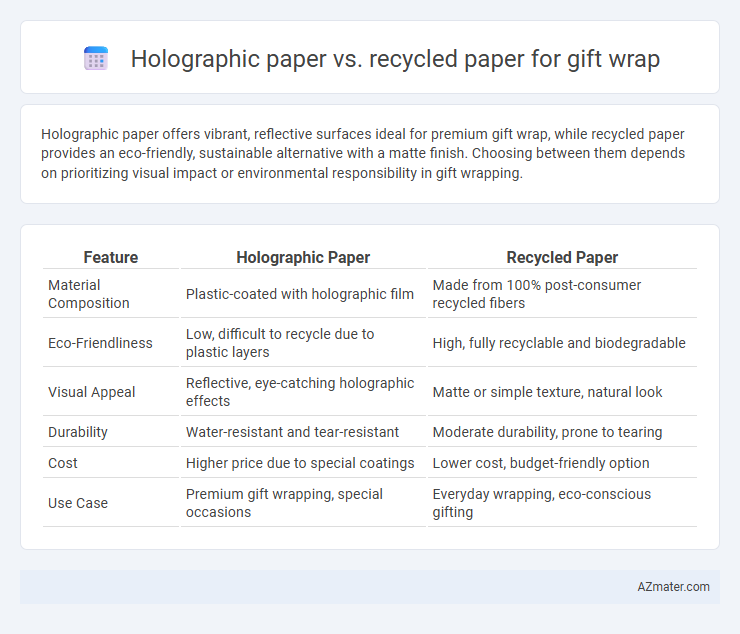Holographic paper offers vibrant, reflective surfaces ideal for premium gift wrap, while recycled paper provides an eco-friendly, sustainable alternative with a matte finish. Choosing between them depends on prioritizing visual impact or environmental responsibility in gift wrapping.
Table of Comparison
| Feature | Holographic Paper | Recycled Paper |
|---|---|---|
| Material Composition | Plastic-coated with holographic film | Made from 100% post-consumer recycled fibers |
| Eco-Friendliness | Low, difficult to recycle due to plastic layers | High, fully recyclable and biodegradable |
| Visual Appeal | Reflective, eye-catching holographic effects | Matte or simple texture, natural look |
| Durability | Water-resistant and tear-resistant | Moderate durability, prone to tearing |
| Cost | Higher price due to special coatings | Lower cost, budget-friendly option |
| Use Case | Premium gift wrapping, special occasions | Everyday wrapping, eco-conscious gifting |
Introduction to Gift Wrap Materials
Holographic paper features a shimmering, iridescent surface that enhances the visual appeal of gift wrap, making it ideal for festive occasions and luxury presentations. Recycled paper offers an eco-friendly alternative, boasting biodegradable properties and reduced environmental impact while maintaining durability and printability. Choosing between holographic and recycled paper depends on prioritizing aesthetic vibrancy or sustainability in gift wrapping.
What is Holographic Paper?
Holographic paper features a surface embedded with microstructures that reflect light to create a shimmering, rainbow-like effect, making it a popular choice for visually striking gift wrap. Unlike recycled paper, which is made from reused fibers to promote sustainability, holographic paper often contains plastic laminates and metallic coatings that enhance durability and shine but may pose recycling challenges. This contrast in materials influences the environmental footprint and recycling options for gift wrapping, with holographic paper prioritizing aesthetic appeal over eco-friendliness.
What is Recycled Paper?
Recycled paper for gift wrap is made from recovered fibers that have been processed to reduce waste and conserve natural resources, offering an eco-friendly alternative to traditional paper. Unlike holographic paper, which is typically coated with plastic and metallic films for a shiny, reflective finish, recycled paper emphasizes sustainability and biodegradability without the use of harmful additives. Choosing recycled paper supports environmental conservation efforts by minimizing landfill contributions and lowering carbon emissions during production.
Visual Appeal: Holographic vs. Recycled Paper
Holographic paper delivers a striking and vibrant visual appeal with its reflective, multi-colored surface that captures and refracts light, creating a dynamic and eye-catching effect ideal for festive occasions. In contrast, recycled paper offers a more natural, subdued aesthetic with textured and matte finishes that emphasize eco-friendliness and rustic charm. The choice between holographic and recycled paper for gift wrap ultimately depends on the desired impression: bold and dazzling versus understated and environmentally conscious.
Environmental Impact Comparison
Holographic paper for gift wrap typically contains a plastic film that complicates recycling and contributes to landfill waste, making it less environmentally sustainable compared to recycled paper. Recycled paper gift wrap significantly reduces resource consumption and carbon emissions by repurposing existing paper fibers and minimizing deforestation. Choosing recycled paper supports circular economy principles and lowers ecological footprints, while holographic paper's production and disposal pose greater environmental challenges.
Durability and Functionality
Holographic paper offers superior durability with a moisture-resistant and tear-resistant surface, making it ideal for maintaining an elegant appearance in gift wrapping. Recycled paper is eco-friendly but tends to be less durable, often prone to tearing and creasing under stress, which can affect the presentation of the gift. Functionally, holographic paper provides a visually striking, reflective finish suitable for festive occasions, while recycled paper caters to sustainable choices with a matte, natural texture.
Price and Accessibility
Holographic paper for gift wrap typically costs 20-50% more than recycled paper due to its specialized manufacturing process and reflective materials. Accessibility of holographic paper is limited, often found in specialty stores or online marketplaces, whereas recycled paper is widely available in supermarkets, craft stores, and bulk retailers. Consumers seeking eco-friendly and budget-friendly options tend to prefer recycled paper, benefiting from its lower price and easy procurement.
Customization and Creative Uses
Holographic paper offers vibrant, reflective surfaces that enhance customization with dynamic color shifts and embossed patterns ideal for eye-catching gift wrap designs. Recycled paper prioritizes eco-friendly customization, allowing for unique textures and printable surfaces that promote sustainability while supporting creative printing techniques like stamping or hand-painting. Both materials enable tailored gift presentations, but holographic paper excels in visual impact, whereas recycled paper emphasizes environmental consciousness and artistic versatility.
Sustainability Trends in Gift Wrapping
Holographic paper, often made with non-recyclable plastics and metallic coatings, presents significant challenges for environmental sustainability in gift wrapping due to its lack of biodegradability and difficulty in recycling. Recycled paper gift wrap, on the other hand, aligns with sustainability trends by reducing waste, conserving resources, and supporting circular economies through reusing post-consumer materials. Embracing recycled paper options contributes to lowering carbon footprints and promoting eco-friendly packaging solutions within the gift wrapping industry.
Choosing the Right Paper for Your Needs
Holographic paper offers vibrant, eye-catching designs perfect for special occasions, while recycled paper provides an eco-friendly and sustainable option for environmentally conscious consumers. Choosing the right paper depends on the balance between aesthetic appeal and environmental impact, with holographic paper excelling in visual effect and recycled paper prioritizing reduced carbon footprint. For gifts requiring a striking presentation, holographic wrap enhances luxury, whereas recycled wrap supports green values and biodegradability.

Infographic: Holographic paper vs Recycled paper for Gift wrap
 azmater.com
azmater.com